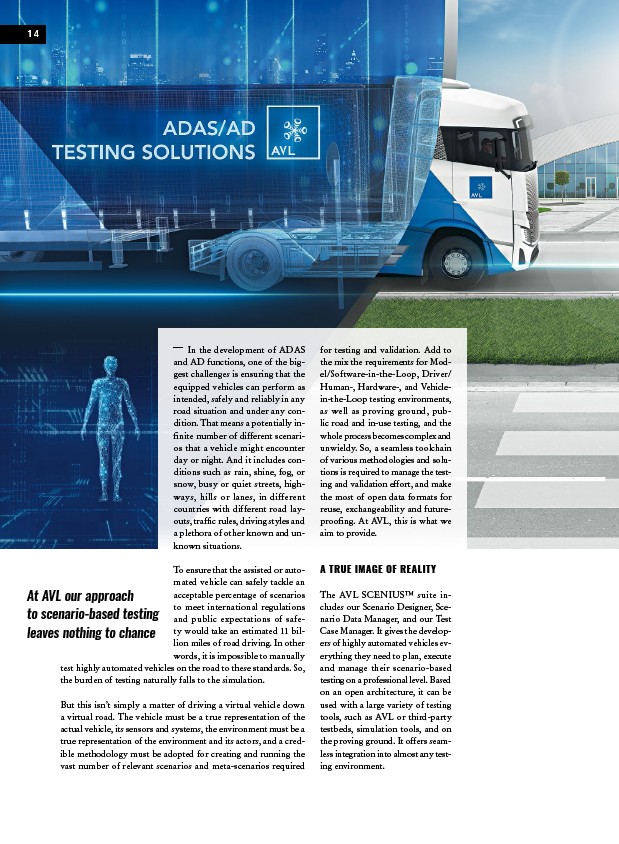
1 4
for testing and validation. Add to
the mix the requirements for Mod-el/
Software-in-the-Loop, Driver/
Human-, Hardware-, and Vehicle-in-
the-Loop testing environments,
as well as proving ground, pub-lic
road and in-use testing, and the
whole process becomes complex and
unwieldy. So, a seamless toolchain
of various methodologies and solu-tions
is required to manage the test-ing
and validation effort, and make
the most of open data formats for
reuse, exchangeability and future-proofing.
At AVL, this is what we
aim to provide.
A TRUE IMAGE OF REALITY
The AVL SCENIUS™ suite in-cludes
our Scenario Designer, Sce-nario
Data Manager, and our Test
Case Manager. It gives the develop-ers
of highly automated vehicles ev-erything
they need to plan, execute
and manage their scenario-based
testing on a professional level. Based
on an open architecture, it can be
used with a large variety of testing
tools, such as AVL or third-party
testbeds, simulation tools, and on
the proving ground. It offers seam-less
integration into almost any test-ing
environment.
In the development of ADAS
and AD functions, one of the big-gest
challenges is ensuring that the
equipped vehicles can perform as
intended, safely and reliably in any
road situation and under any con-dition.
That means a potentially in-finite
number of different scenari-os
that a vehicle might encounter
day or night. And it includes con-ditions
such as rain, shine, fog, or
snow, busy or quiet streets, high-ways,
hills or lanes, in different
countries with different road lay-outs,
traffic rules, driving styles and
a plethora of other known and un-known
situations.
To ensure that the assisted or auto-mated
vehicle can safely tackle an
acceptable percentage of scenarios
to meet international regulations
and public expectations of safe-ty
would take an estimated 11 bil-lion
miles of road driving. In other
words, it is impossible to manually
At AVL our approach
to scenario-based testing
leaves nothing to chance
test highly automated vehicles on the road to these standards. So,
the burden of testing naturally falls to the simulation.
But this isn’t simply a matter of driving a virtual vehicle down
a virtual road. The vehicle must be a true representation of the
actual vehicle, its sensors and systems, the environment must be a
true representation of the environment and its actors, and a cred-ible
methodology must be adopted for creating and running the
vast number of relevant scenarios and meta-scenarios required